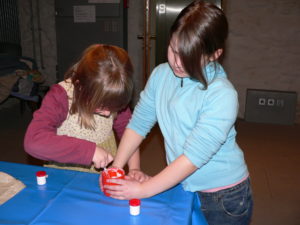Children's birthday parties

Image: Radolfzell town council
How about a children’s birthday party in historic walls, where the little ones can celebrate like the grown-ups?
The guided party lasts approx. 2 hours including a short break during which you can provide the children with food and drinks (please bring your own). Plates and drinking cups can be provided.
Fee: €80 (€50 for Zeller Karte holders), €100 at weekends (€70 for Zeller Karte holders), including admission for 2 accompanying adults. Information and booking: 077 32 – 815 40 or museum@radolfzell.de
For fire safety reasons, no candles may be lit in the museum building.
For children aged 6 and over
Fun and games through the museum
We go on a journey of discovery through the museum and playfully explore various objects and rooms in the museum. Through perception games (seeing, feeling, hearing, smelling) the children get to know the museum with all their senses. Group games and pair games alternate with individual games.
For children aged 8 and over
City rally
The rally consists of two rounds: The first round begins in the museum. Using an illustrated quiz sheet, the children explore parts of the museum before going on a hunt for buildings in the old town and answering questions about them. At the end, the “Radolfzell City Detective” diplomas are awarded. When searching for pictures, the whole group always stays together, no subgroup moves through the city alone without supervision. Very suitable for active children. However, the children must be able to read and write and know their way around Radolfzell!
Biedermeier fashion show
What do we know about the Biedermeier period? What inventions have already been made? What amenities did you have to do without back then? Using pictures, we immerse ourselves in the past and imagine what life was like back then. We then slip into costumes from the Biedermeier period and dress up as ladies and gentlemen of high society and servants. What rules of conduct had to be observed? We practise greetings with curtsies, bows and hand kisses. And what role does the fan play in this?
Making a herbal ointment
We get to know the classic steps for making a herbal ointment: Harvesting the herbs in the museum garden – quality control (sorting out old leaf parts) – chopping with a knife on small boards – making an oil extract – filtering – hardening – bottling – labeling. We also learn interesting facts about the properties and origins of medicinal herbs. The children can later use the experience they have gained to make herbal ointments at home.
Pill production
Who doesn’t know them, the small or large white or colored pills? But how are they actually made? We want to investigate this question practically by first crushing the pill mass in a mortar according to an original pharmacist’s recipe and then rolling practice pills on the pill board. We then make delicious pills from marzipan and powdered sugar to take home with us.
Play like in the Middle Ages
Together we will explore the painting “Children’s Games” by the Dutch painter Pieter Bruegel the Elder from 1560 and find out what games children played back then. In the process, we discover both games that are still familiar to us today and those that are unknown to us. We then take ourselves back in time and play various of the illustrated games. In good weather, some games can also be played in front of the museum.
Painting and writing like in the Middle Ages
Introduction to book production and book illumination in the Middle Ages. We trace the old writings with a pen (fountain pen or goose quill) and ink. We design initials and decorations ourselves according to templates. Children must be able to write well for this program! If younger children are present, the color production is used. A color is rubbed on and a watercolor is painted with it.
Living Middle Ages: Clothes make the man
Who still knows the Gugel or the Gambeson? With this program, we literally slip into the Middle Ages. After an introduction to Radolfzell in the year 1500, we will take part in a “fashion show” to find out who wore what clothes back then and what the clothes said about the people of the time.